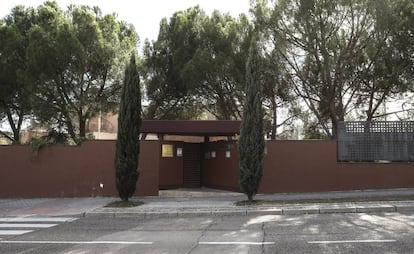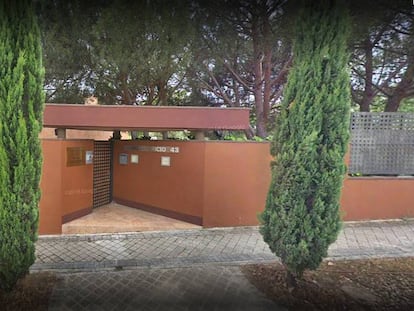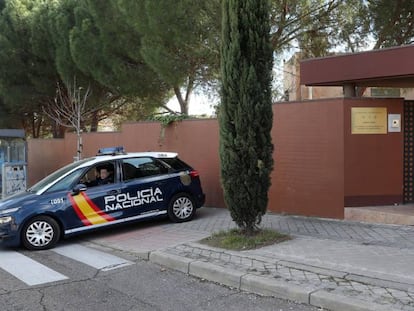Spanish judge issues international arrest warrants against two attackers of the North Korean embassy
The US denies any involvement in the mysterious break-in, although the group leader contacted the FBI

The Spanish judge investigating an attack on the North Korean embassy in Madrid last month has issued international arrest warrants against two of the assailants, police and judicial sources have confirmed to EL PAÍS.
Judge José de la Mata, of Spain’s High Court, the Audiencia Nacional, is charging them with six crimes, including unlawful detention, violent robbery and criminal association.
Hong Chang left in a rental car hired to the name of one Oswaldo Trump
At least some of the 10 individuals who broke into the North Korean embassy in Madrid on February 22, assaulting personnel and taking audiovisual material with them, immediately fled to the United States via Portugal, the court investigation shows.
The US State Department deputy spokesman, Robert Palladino, said on Tuesday that “the government of the United States had nothing to do” with the break-in.
After EL PAÍS revealed that at least two of the assailants had been identified and had ties with the CIA, The Washington Post published an article ruling out the agency’s involvement and pointing at a small North Korean dissident group called Cheollima Civil Defense or Free Joseon, which had not claimed responsibility for the attack at that time. (On Tuesday, this group issued a statement claiming responsibility but denying the use of force.)
The main goal of the break-in, according to the judge’s report, was to convince the embassy’s commercial attaché, Yun Sok So, to defect. But this offer was not viable if there wasn’t a government standing ready to offer him asylum.
Judge José de la Mata is charging the assailants with six crimes, including unlawful detention, violent robbery and criminal association
De la Mata has lifted the seal on the investigation, which shows that the intruders fled Spain right after taking the audiovisual material from the embassy. After splitting up into four groups, they traveled to Lisbon, where at least one of them – their alleged leader, Adrian Hong Chang – boarded a plane for Newark, New Jersey, which landed at 2pm local time on February 23. Five days after the break-in, Hong Chang contacted the FBI to provide information about the incident.
According to the investigation, Hong Chang is a US resident who holds Mexican citizenship. Six hours before the attack on the embassy, he purchased “tactical and combat equipment,” including large knives, handgun replicas and handcuffs. Four other members of the group, including a South Korean national named Woo Ram Lee and a US citizen named Sam Ryu, spent over €600 at a local hardware store on a large purchase that included pliers, duct tape, shears and a telescopic ladder.
At 4.34pm on February 22, the group leader rang the doorbell of the embassy, located in Madrid’s upscale Aravaca district, and asked to see the commercial attaché, Yun Sok So, whom he had already met two weeks earlier after posing as an entrepreneur with offices in the United Arab Emirates and Canada who was interested in investing in North Korea.
According to the judge’s report, while Hong Chang was waiting for the attaché to arrive, he let his nine aides inside the building, and they began “violently hitting” embassy staff members, whom they restrained with handcuffs and cable ties.
The commercial attaché was “beaten and taken by force to one of the bathrooms,” according to the court papers. As he was resisting, the intruders handcuffed him and covered his head with a bag, and pointed what looked like firearms at his neck. The assailants also broke open the door of the room where the attaché’s wife and son had taken refuge.
The commercial attaché was “beaten and taken by force to one of the bathrooms,” according to the court papers
The wife of another staff member also hid inside a locked room, and was able to jump out the window and run for help, according to the judge’s reconstruction of events. A passerby who saw her called the police, and when officers showed up at the embassy, they were greeted at the door by Hong Chang himself, posing as a North Korean diplomat, who assured them that nothing was amiss.
Eight of the intruders left the compound at around 9.40pm, taking computers, pen drives, hard drives and a cellphone with them. They drove off on embassy vehicles that were later abandoned in different parts of Madrid and Pozuelo de Alarcón, with the keys in the ignition. Hong Chang and an aide left later out the back door, in a rental car that they had hired through an app to the name of one Oswaldo Trump. Staff members were left inside the embassy in handcuffs.
Investigators also found that Hong Chang contacted the Madrid hotel where he had been staying, and asked them to send his luggage straight to the US as he had to leave urgently for Paris and would not be able to return for it. In fact, Hong Chang was boarding a plane for Newark, New Jersey.
Spanish police lost track of him after February 27, when he contacted the FBI to provide information about the incident and hand over the audiovisual material “allegedly obtained” at the embassy.
English version by Susana Urra.
Tu suscripción se está usando en otro dispositivo
¿Quieres añadir otro usuario a tu suscripción?
Si continúas leyendo en este dispositivo, no se podrá leer en el otro.
FlechaTu suscripción se está usando en otro dispositivo y solo puedes acceder a EL PAÍS desde un dispositivo a la vez.
Si quieres compartir tu cuenta, cambia tu suscripción a la modalidad Premium, así podrás añadir otro usuario. Cada uno accederá con su propia cuenta de email, lo que os permitirá personalizar vuestra experiencia en EL PAÍS.
¿Tienes una suscripción de empresa? Accede aquí para contratar más cuentas.
En el caso de no saber quién está usando tu cuenta, te recomendamos cambiar tu contraseña aquí.
Si decides continuar compartiendo tu cuenta, este mensaje se mostrará en tu dispositivo y en el de la otra persona que está usando tu cuenta de forma indefinida, afectando a tu experiencia de lectura. Puedes consultar aquí los términos y condiciones de la suscripción digital.
More information
Archived In
Últimas noticias
Most viewed
- Reinhard Genzel, Nobel laureate in physics: ‘One-minute videos will never give you the truth’
- Oona Chaplin: ‘I told James Cameron that I was living in a treehouse and starting a permaculture project with a friend’
- Pablo Escobar’s hippos: A serious environmental problem, 40 years on
- Charles Dubouloz, mountaineering star, retires at 36 with a farewell tour inspired by Walter Bonatti
- Why we lost the habit of sleeping in two segments and how that changed our sense of time










































